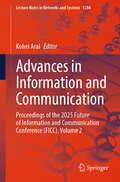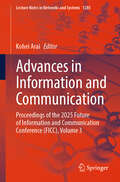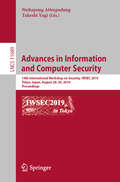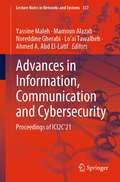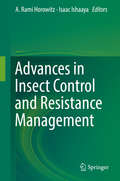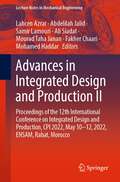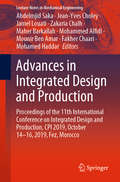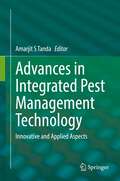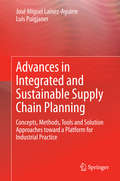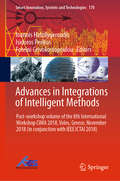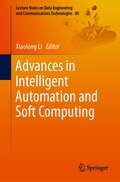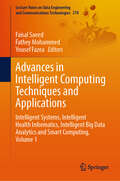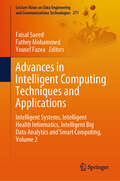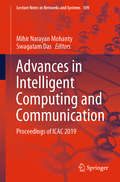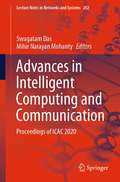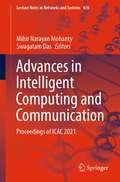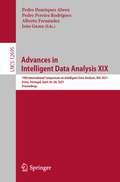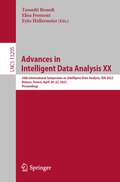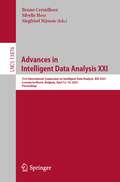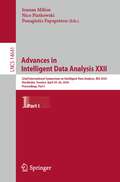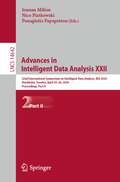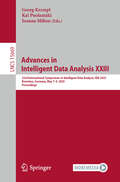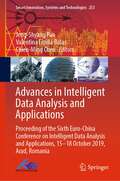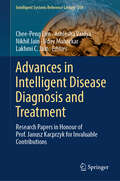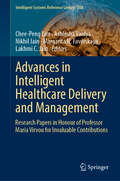- Table View
- List View
Advances in Information and Communication: Proceedings of the 2025 Future of Information and Communication Conference (FICC), Volume 2 (Lecture Notes in Networks and Systems #1284)
by Kohei AraiThis book comprises the proceedings of the Future of Information and Communication Conference (FICC) 2025, held on 28-29 April 2025 in Berlin, Germany. The conference brought together leading researchers, industry experts, and academics from across the globe to discuss the latest advancements, challenges, and opportunities in the rapidly evolving field of information and communication technologies. The conference received an impressive 401 submissions, of which 138 high-quality papers were selected after a rigorous peer-review process. These contributions span a diverse range of topics, including artificial intelligence, cybersecurity, data science, networking, human–computer interaction, and more. FICC 2025 provided an engaging platform for collaboration and knowledge exchange, highlighting state-of-the-art research and practical solutions to global challenges. This proceedings book serves as a valuable resource for researchers, practitioners, and innovators seeking insights into the future of information and communication technologies.
Advances in Information and Communication: Proceedings of the 2025 Future of Information and Communication Conference (FICC), Volume 3 (Lecture Notes in Networks and Systems #1285)
by Kohei AraiThis book comprises the proceedings of the Future of Information and Communication Conference (FICC) 2025, held on 28-29 April 2025 in Berlin, Germany. The conference brought together leading researchers, industry experts, and academics from across the globe to discuss the latest advancements, challenges, and opportunities in the rapidly evolving field of information and communication technologies. The conference received an impressive 401 submissions, of which 138 high-quality papers were selected after a rigorous peer-review process. These contributions span a diverse range of topics, including artificial intelligence, cybersecurity, data science, networking, human–computer interaction, and more. FICC 2025 provided an engaging platform for collaboration and knowledge exchange, highlighting state-of-the-art research and practical solutions to global challenges. This proceedings book serves as a valuable resource for researchers, practitioners, and innovators seeking insights into the future of information and communication technologies.
Advances in Information and Computer Security: 14th International Workshop on Security, IWSEC 2019, Tokyo, Japan, August 28–30, 2019, Proceedings (Lecture Notes in Computer Science #11689)
by Nuttapong Attrapadung Takeshi YagiThis book constitutes the refereed proceedings of the 14th International Workshop on Security, IWSEC 2019, held in Tokyo, Japan, in August 2019. The 18 regular papers and 5 short papers presented in this volume were carefully reviewed and selected from 61 submissions. They were organized in topical sections named: Public-Key Primitives; Cryptanalysis on Public-Key Primitives; Cryptographic Protocols; Symmetric-Key Primitives; Malware Detection and Classification; Intrusion Detection and Prevention; Web and Usable Security; Cryptanalysis on Symmetric-Key Primitives; and Forensics.
Advances in Information, Communication and Cybersecurity: Proceedings of ICI2C’21 (Lecture Notes in Networks and Systems #357)
by Yassine Maleh Mamoun Alazab Lo’ai Tawalbeh Noreddine Gherabi Ahmed A. Abd El-LatifThis book gathers the proceedings of the International Conference on Information, Communication and Cybersecurity, held on November 10–11, 2021, in Khouribga, Morocco. The conference was jointly coorganized by The National School of Applied Sciences of Sultan Moulay Slimane University, Morocco, and Charles Darwin University, Australia. This book provides an opportunity to account for state-of-the-art works, future trends impacting information technology, communications, and cybersecurity, focusing on elucidating the challenges, opportunities, and inter-dependencies that are just around the corner. This book is helpful for students and researchers as well as practitioners.ICI2C 2021 was devoted to advances in smart information technologies, communication, and cybersecurity. It was considered a meeting point for researchers and practitioners to implement advanced information technologies into various industries. There were 159 paper submissions from 24 countries. Each submission was reviewed by at least three chairs or PC members. We accepted 54 regular papers (34\%). Unfortunately, due to limitations of conference topics and edited volumes, the Program Committee was forced to reject some interesting papers, which did not satisfy these topics or publisher requirements. We would like to thank all authors and reviewers for their work and valuable contributions. The friendly and welcoming attitude of conference supporters and contributors made this event a success!
Advances in Insect Control and Resistance Management
by Isaac Ishaaya A. Rami HorowitzThe present book covers different approaches regardingadvances in insect control and in resistance management: some chapters presentand summarize general strategies or tactics for managing insect pests, whileothers cover alternative and non-chemical methods for controlling pests;another part is devoted to different aspects of insecticides, insecticideresistance mechanisms and management.
Advances in Integrated Design and Production II: Proceedings of the 12th International Conference on Integrated Design and Production, CPI 2022, May 10–12, 2022, ENSAM, Rabat, Morocco (Lecture Notes in Mechanical Engineering)
by Fakher Chaari Mohamed Haddar Samir Lamouri Ali Siadat Lahcen Azrar Abdelilah Jalid Mourad Taha JananThis book reports on innovative concepts and practical solutions at the intersection between engineering design, production and industrial management. It covers cutting-edge design, modeling and control of dynamic and multiphysics systems, knowledge management systems in industry 4.0, cyber-physical production systems, additive and sustainable manufacturing and many other related topics. It also highlights important collaborative works between different countries and between industry and universities. Gathering the proceedings of the 12th International Conference on Integrated Design and Production, CPI 2022, held on May 10-12, 2022, at École Nationale Supérieure d'Arts et Métiers (ENSAM), in Rabat, Morocco, this book gathers carefully peer-reviewed chapters, with extensive information for researchers and professionals in the broad area of engineering design, production and management.
Advances in Integrated Design and Production: Proceedings of the 11th International Conference on Integrated Design and Production, CPI 2019, October 14-16, 2019, Fez, Morocco (Lecture Notes in Mechanical Engineering)
by Jean-Yves Choley Fakher Chaari Mohamed Haddar Mounir Ben Amar Maher Barkallah Jamel Louati Abdelmjid Saka Zakaria Chalh Mohammed AlfidiThis book reports on innovative concepts and practical solutions at the intersection between engineering design, engineering production and industrial management. It covers cutting-edge design, modeling and control of dynamic and multiphysics systems, knowledge management systems in industry 4.0, cyber-physical production systems, additive and sustainable manufacturing and many other related topics. The original, carefully selected, peer-reviewed chapters highlight collaborative works between different countries and between industry and universities, thus offering a timely snapshot for the research and industrial communities alike, as well as a bridge to facilitate communication and collaboration.
Advances in Integrated Pest Management Technology: Innovative and Applied Aspects
by Amarjit S TandaThe UN's Food and Agriculture Organization defines integrated pest management (IPM) as "the careful consideration of all available pest control techniques and subsequent integration of appropriate measures that discourage the development of pest populations and keep pesticides and other interventions to levels that are economically justified and reduce or minimize risks to human health and the environment. IPM emphasizes the growth of a healthy crop with the least possible disruption to agro-ecosystems and encourages natural pest control mechanisms. "Although this is a concept championed since the 70s, recent advances in agricultural biotechnologies and unfortunately, new problems brought on by global climate change warrant a reevaluation of how IPM can be implemented. This book aims at bringing out a comprehensive collection of information on all aspects of advances in integrated pest management technology in agriculture systems worldwide. The main focus of this book is to address the nano-biotechnology as sustainable solutions, biogenetic insect resistant plants in integrated pest management technology (IPMT), and DNA barcoding of insects and role of protease inhibitors in recent management trends. It also highlights the advances in integrated management of insect pests of stored grains, and use of bee pollinator’s as a livelihood security to the people worldwide. Step-by-step descriptions, accompanied by numerous photographs and schematic drawings, are provided on IPMT under changing climate, and habitat manipulation in crops. This book thus provides a forward-looking foundation for IPMT systems and its use in crop production.
Advances in Integrated and Sustainable Supply Chain Planning: Concepts, Methods, Tools and Solution Approaches toward a Platform for Industrial Practice
by Luis Puigjaner José Miguel Laínez-AguirreDecision making at the enterprise level often encompass not only production operations and product R&D, but other strategic functions such as financial planning and marketing. With the aim of maximizing growth and a firm's value, companies often focus on co-ordinating these functional components as well as traditional hierarchical decision levels. Understanding this interplay can enhance enterprise capabilities of adaptation and response to uncertainties arising from internal processes as well as the external environment. This book presents concepts, methods, tools and solutions based on mathematical programming, which provides the quantitative support needed for integrated decision-making and ultimately for improving the allocation of overall corporate resources (e. g. , materials, cash and personnel). Through a systems perspective, the integrated planning of the supply chain also promotes activities of reuse, reduction and recycling for achieving more sustainable environmental impacts of production/distribution networks. Thus, this book presents, for the first time, a unique integrated vision of the Enterprise Supply Chain Planning and provides a comprehensive account of the state of the art models, methods and tools available to address the above mentioned features of the modern supply chain. It offers a comprehensive review of the associated literature of supply chain management and then systematically builds on this knowledge base to develop the mathematical models representing each of the core functional units and decision levels of the corporation and shows how they can be integrated into a holistic decision problem formulation. Abundant illustrations and tables help maximize reader insights into the problems discussed with several case studies and industry application also examined. This book is intended as a textbook for academics (PhD, MSc), researchers and industry decision-makers, who are involved in the design, retrofit and evaluation of alternative scenarios for the improvement of the supply chain.
Advances in Integrations of Intelligent Methods: Post-workshop volume of the 8th International Workshop CIMA 2018, Volos, Greece, November 2018 (in conjunction with IEEE ICTAI 2018) (Smart Innovation, Systems and Technologies #170)
by Ioannis Hatzilygeroudis Isidoros Perikos Foteini GrivokostopoulouThis book presents a number of research efforts in combining AI methods or techniques to solve complex problems in various areas. The combination of different intelligent methods is an active research area in artificial intelligence (AI), since it is believed that complex problems can be more easily solved with integrated or hybrid methods, such as combinations of different soft computing methods (fuzzy logic, neural networks, and evolutionary algorithms) among themselves or with hard AI technologies like logic and rules; machine learning with soft computing and classical AI methods; and agent-based approaches with logic and non-symbolic approaches. Some of the combinations are already extensively used, including neuro-symbolic methods, neuro-fuzzy methods, and methods combining rule-based and case-based reasoning. However, other combinations are still being investigated, such as those related to the semantic web, deep learning and swarm intelligence algorithms. Most are connected with specific applications, while the rest are based on principles.
Advances in Intelligent Automation and Soft Computing (Lecture Notes on Data Engineering and Communications Technologies #80)
by Xiaolong LiThis book presents select proceedings of the International Conference on Intelligent Automation and Soft Computing (IASC2021). Various topics covered in this book include AI algorithm, neural networks, pattern recognition, machine learning, blockchain technology, system engineering, computer vision and image processing, adaptive control and robotics, big data and data processing, networking and security. The book is a valuable reference for beginners, researchers, and professionals interested in artificial intelligence, automation, and soft computing.
Advances in Intelligent Computing Techniques and Applications: Intelligent Systems, Intelligent Health Informatics, Intelligent Big Data Analytics and Smart Computing, Volume 1 (Lecture Notes on Data Engineering and Communications Technologies #210)
by Faisal Saeed Fathey Mohammed Yousef FazeaThis book presents the papers included in the proceedings of the 7th International Conference of Reliable Information and Communication Technology 2023 (IRICT 2023) that was held in Pulai Springs Resorts, Johor, Malaysia on 27-28, December 2023. IRICT 2023 is organized by the Yemeni Scientists Research Group (YSRG) and Big Data Center in Universiti Teknologi Malaysia (Malaysia) in collaboration with Association for Information Systems – Malaysia Chapter (MyAIS) and College of Engineering, IT and Environment at Charles Darwin University (Australia). IRICT2023 is a forum for the presentation of technological advances in the field of Information and Communication Technology. The main theme of the conference is “Advances in Intelligent Computing Techniques and Applications”. The book discusses several research topics such as Health Informatics, Artificial Intelligence, Soft Computing, Data Science, Big Data Analytics, Internet of Things (IoT), Intelligent Communication Systems, Cyber Security, and Information System. These papers were presented in three parallel sessions during the two days.
Advances in Intelligent Computing Techniques and Applications: Intelligent Systems, Intelligent Health Informatics, Intelligent Big Data Analytics and Smart Computing, Volume 2 (Lecture Notes on Data Engineering and Communications Technologies #211)
by Faisal Saeed Fathey Mohammed Yousef FazeaThis book presents the papers included in the proceedings of the 7th International Conference of Reliable Information and Communication Technology 2023 (IRICT 2023) that was held in Pulai Springs Resorts, Johor, Malaysia on 27-28, December 2023. IRICT 2023 is organized by the Yemeni Scientists Research Group (YSRG) and Big Data Center in Universiti Teknologi Malaysia (Malaysia) in collaboration with Association for Information Systems – Malaysia Chapter (MyAIS) and College of Engineering, IT and Environment at Charles Darwin University (Australia). IRICT2023 is a forum for the presentation of technological advances in the field of Information and Communication Technology. The main theme of the conference is “Advances in Intelligent Computing Techniques and Applications”. The book discusses several research topics such as Health Informatics, Artificial Intelligence, Soft Computing, Data Science, Big Data Analytics, Internet of Things (IoT), Intelligent Communication Systems, Cyber Security, and Information System. These papers were presented in three parallel sessions during the two days.
Advances in Intelligent Computing and Communication: Proceedings of ICAC 2019 (Lecture Notes in Networks and Systems #109)
by Swagatam Das Mihir Narayan MohantyThis book features high-quality research papers presented at the 2nd International Conference on Intelligent Computing and Advances in Communication (ICAC 2019), held at Siksha ‘O’ Anusandhan Deemed to be University, Bhubaneswar, Odisha, India, in November 2019. Covering a wide variety of topics, including management of clean and smart energy systems and environmental challenges, it is a valuable resource for researchers and practicing engineers working in various fields of renewable energy generation, and clean and smart energy management.
Advances in Intelligent Computing and Communication: Proceedings of ICAC 2020 (Lecture Notes in Networks and Systems #202)
by Swagatam Das Mihir Narayan MohantyThis book presents high-quality research papers presented at the 3rd International Conference on Intelligent Computing and Advances in Communication (ICAC 2020) organized by Siksha ‘O’ Anusandhan Deemed to be University, Bhubaneswar, Odisha, India, in November 2020. This book brings out the new advances and research results in the fields of theoretical, experimental, and applied signal and image processing, soft computing, networking, and antenna research. Moreover, it provides a comprehensive and systematic reference on the range of alternative conversion processes and technologies.
Advances in Intelligent Computing and Communication: Proceedings of ICAC 2021 (Lecture Notes in Networks and Systems #430)
by Swagatam Das Mihir Narayan MohantyThe book presents high-quality research papers presented at 4th International Conference on Intelligent Computing and Advances in Communication (ICAC 2021) organized by Siksha ‘O’ Anusandhan, Deemed to be University, Bhubaneswar, Odisha, India, in November 2021. This book brings out the new advances and research results in the fields of theoretical, experimental, and applied signal and image processing, soft computing, networking, and antenna research. Moreover, it provides a comprehensive and systematic reference on the range of alternative conversion processes and technologies.
Advances in Intelligent Data Analysis XIX: 19th International Symposium on Intelligent Data Analysis, IDA 2021, Porto, Portugal, April 26–28, 2021, Proceedings (Lecture Notes in Computer Science #12695)
by João Gama Pedro Henriques Abreu Alberto Fernández Pedro Pereira RodriguesThis book constitutes the proceedings of the 19th International Symposium on Intelligent Data Analysis, IDA 2021, which was planned to take place in Porto, Portugal. Due to the COVID-19 pandemic the conference was held online during April 26-28, 2021.The 35 papers included in this book were carefully reviewed and selected from 113 submissions. The papers were organized in topical sections named: modeling with neural networks; modeling with statistical learning; modeling language and graphs; and modeling special data formats.
Advances in Intelligent Data Analysis XX: 20th International Symposium on Intelligent Data Analysis, IDA 2022, Rennes, France, April 20–22, 2022, Proceedings (Lecture Notes in Computer Science #13205)
by Elisa Fromont Eyke Hüllermeier Tassadit BouadiThis book constitutes the proceedings of the 20th International Symposium on Intelligent Data Analysis, IDA 2022, which was held in Rennes, France, during April 20-22, 2022. The 31 papers included in this book were carefully reviewed and selected from 73 submissions. They deal with high quality, novel research in intelligent data analysis.
Advances in Intelligent Data Analysis XXI: 21st International Symposium on Intelligent Data Analysis, IDA 2023, Louvain-la-Neuve, Belgium, April 12–14, 2023, Proceedings (Lecture Notes in Computer Science #13876)
by Siegfried Nijssen Bruno Crémilleux Sibylle HessThis book constitutes the proceedings of the 21st International Symposium on Intelligent Data Analysis, IDA 2022, which was held in Louvain-la-Neuve, Belgium, during April 12-14, 2023. The 38 papers included in this book were carefully reviewed and selected from 91 submissions. IDA is an international symposium presenting advances in the intelligent analysis of data. Distinguishing characteristics of IDA are its focus on novel, inspiring ideas, its focus on research, and its relatively small scale.
Advances in Intelligent Data Analysis XXII: 22nd International Symposium on Intelligent Data Analysis, IDA 2024, Stockholm, Sweden, April 24–26, 2024, Proceedings, Part I (Lecture Notes in Computer Science #14641)
by Nico Piatkowski Panagiotis Papapetrou Ioanna MiliouThe two volume set LNCS 14641 and 14642 constitutes the proceedings of the 22nd International Symposium on Intelligent Data Analysis, IDA 2024, which was held in Stockholm, Sweden, during April 24-26, 2024. The 40 full and 3 short papers included in the proceedings were carefully reviewed and selected from 94 submissions. IDA is an international symposium presenting advances in the intelligent analysis of data. Distinguishing characteristics of IDA are its focus on novel, inspiring ideas, its focus on research, and its relatively small scale.
Advances in Intelligent Data Analysis XXII: 22nd International Symposium on Intelligent Data Analysis, IDA 2024, Stockholm, Sweden, April 24–26, 2024, Proceedings, Part II (Lecture Notes in Computer Science #14642)
by Nico Piatkowski Panagiotis Papapetrou Ioanna MiliouThe two volume set LNCS 14641 and 14642 constitutes the proceedings of the 22nd International Symposium on Intelligent Data Analysis, IDA 2024, which was held in Stockholm, Sweden, during April 24-26, 2024. The 40 full and 3 short papers included in the proceedings were carefully reviewed and selected from 94 submissions. IDA is an international symposium presenting advances in the intelligent analysis of data. Distinguishing characteristics of IDA are its focus on novel, inspiring ideas, its focus on research, and its relatively small scale.
Advances in Intelligent Data Analysis XXIII: 23rd International Symposium on Intelligent Data Analysis, IDA 2025, Konstanz, Germany, May 7–9, 2025, Proceedings (Lecture Notes in Computer Science #15669)
by Georg Krempl Ioanna Miliou Kai PuolamäkiThis volume constitutes the proceedings of the 23rd International Symposium on Intelligent Data Analysis, IDA 2025, which was held in Konstanz, Germany, during May 7–9, 2025. The 35 full papers included in the proceedings were carefully reviewed and selected from 91 submissions. They were organized in topical sections as follows: Applications of data science, foundations of data science; natural language processing; temporal and streaming data; and explainable and interpretable data science.
Advances in Intelligent Data Analysis and Applications: Proceeding of the Sixth Euro-China Conference on Intelligent Data Analysis and Applications, 15–18 October 2019, Arad, Romania (Smart Innovation, Systems and Technologies #253)
by Jeng-Shyang Pan Valentina Emilia Balas Chien-Ming ChenThis book constitutes the Proceeding of the Sixth International Conference on Intelligent Data Analysis and Applications, October 15–18, 2019, Arad, Romania. This edition is technically co-sponsored by “Aurel Vlaicu” University of Arad, Romania, Southwest Jiaotong University, Fujian University of Technology, Chang’an University, Shandong University of Science and Technology, Fujian Provincial Key Lab of Big Data Mining and Applications, and National Demonstration Center for Experimental Electronic Information and Electrical Technology Education (Fujian University of Technology), China, Romanian Academy, and General Association of Engineers in Romania - Arad Section. The book covers a range of topics: Machine Learning, Intelligent Control, Pattern Recognition, Computational Intelligence, Signal Analysis, Modeling and Visualization, Multimedia Sensing and Sensory Systems, Signal control, Imaging and Processing, Information System Security, Cryptography and Cryptanalysis, Databases and Data Mining, Information Hiding, Cloud Computing, Information Retrieval and Integration, Robotics, Control, Agents, Command, Control, Communication and Computers (C4), Swarming Technology, Sensor Technology, Smart cities.The book offers a timely, board snapshot of new development including trends and challenges that are yielding recent research directions in different areas of intelligent data analysis and applications. The book provides useful information to professors, researchers, and graduated students in area of intelligent data analysis and applications.
Advances in Intelligent Disease Diagnosis and Treatment: Research Papers in Honour of Prof. Janusz Kacprzyk for Invaluable Contributions (Intelligent Systems Reference Library #259)
by Lakhmi C. Jain Chee-Peng Lim Ashlesha Vaidya Nikhil Jain Uday MahorkarThe book delves into innovations in AI and related computing paradigms for disease detection and diagnosis. The collected chapters elucidate the use of a variety of AI and related methodologies to address specific medical challenges. From detecting pancreatic cancer, classifying micro-emboli in stroke diagnosis, to segmenting brain tumours from MRI data, and more, the culmination of these studies underscores the transformative impact AI and digital technologies can have on healthcare, emphasising their potential to enhance medical treatment and improve patient care.
Advances in Intelligent Healthcare Delivery and Management: Research Papers in Honour of Professor Maria Virvou for Invaluable Contributions (Intelligent Systems Reference Library #258)
by Lakhmi C. Jain Margarita N. Favorskaya Chee-Peng Lim Ashlesha Vaidya Nikhil JainThis book unveils the dynamic fusion of artificial intelligence (AI) and related innovations in healthcare delivery and management. The collected chapters delve into innovative and intelligent methods for improving healthcare services, from electronic health records management, robotics and AI in healthcare, to data-driven decision-making. Readers can discover how AI-based methodologies empower different facets of healthcare delivery and management, building a future where digital technologies are leveraged to enhance the quality and accessibility of healthcare services.
